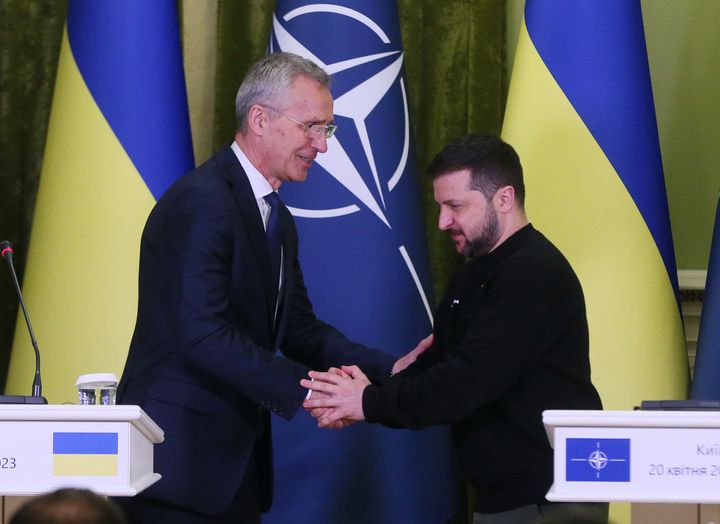
Ukraine’s chances of finally joining NATO – after years of trying to get accepted as a member – seem to be looking up.
During a surprise visit to Kyiv on Thursday, the head of the international military alliance NATO (the North Atlantic Treaty Organisation) revealed that all of its members agreed that Ukraine should join.
This is an outcome Kyiv has been hoping for for a very long time – and part of the reason Moscow launched its invasion into the neighbouring country last year.
So why is it such a big deal? Here’s everything you need to know.
What is NATO?
NATO has 31 member states, including the UK, the US, Canada, France and Germany.
Founded in 1949 after World War 2 by just 12 nations, the political and military alliance vowed to secure peace in Europe and to protect members’ freedom and security, at a time when the Soviet Union was presenting an ever-growing threat.
One of its core principles is “collective defence”, which means an attack against one member is also seen as an attack against all allies.
Now, their combined militaries mean it is the most powerful military alliance in the world although they have rarely been deployed.
Joining requires unanimous approval from every member state and the nation applying needs to have functioning democracy and unresolved external territorial disputes.
Even so, joining can be an arduous process. North Macedonia, for instance, took 20 years to join.

Why does Ukraine want to join NATO?
Ukraine has been calling to join NATO for years, first announcing it in 2002.
It then applied to join the alliance in 2008 – and NATO agreed it would eventually becoming a member – and even included its goals to join NATO and the EU in its constitution in February 2019.
Not only would being a NATO member mean Ukraine was more closely aligned with the West, but NATO’s collective defence principle would offer a buffer from Russia’s bid to reclaim Ukraine and exert its influence.
That’s why Russia’s annexation of the Crimean peninsula in 2014 galvanised Ukraine’s efforts.
It’s also become more of a pressing issue for Kyiv since Russia invaded Ukraine. Although NATO has still been offering support to the country, backing for non-members is limited and it will not offer any of its own troops to fight for Ukraine.
Why is Ukraine joining the alliance so controversial?
If Ukraine were to join NATO, the collective defence principle would mean the whole of the alliance was at war with Russia.
The West has been toeing a precarious line when it comes to direct conflict with Moscow, and trying its best to avoid becoming an active participant in the current Ukraine war.
But, it has been offering training to Ukrainian soldiers, sending vast amounts of equipment and money to the beleaguered nation, which has undoubtedly helped it hold off Russia’s advances.
Joining NATO could mean Russia backs off Ukraine; or it could pull Europe and North America into an international war.
Russia has made it clear it would see any NATO expansion as a direct threat.
Only in March 2022, Zelenskyy acknowledged that joining the alliance was unlikely.
He said: “For years we have heard about the supposedly open door [to NATO] but we have also heard that we should not enter. And this is true and we must admit it.”
At the time, the comment seemed like it could help decrease Russia’s offensives – but the war waged on, so Ukrainian officials put the pressure back on NATO.

What has changed now?
After Ukraine formally requested “accelerated accession” to the alliance last September and some eastern European NATO members called for more clarity on Kyiv’s path to the alliance, Stoltenberg’s surprise Kyiv visit seemed to indicate some movement.
He implied that all NATO members now believe Ukraine will join the alliance – but refused to offer a solid timeline.
He told Ukrainian president Volodymyr Zelenskyy: “Ukraine’s rightful place is in the euro-Atlantic family. Ukraine’s rightful place is in NATO.
“And over time, our support will help you to make this possible.”
He also said that the alliance would continue to offer military support, train troops and offer vast sums of money to the country.
“NATO stands with you today, tomorrow and for as long as it takes,” he said, before inviting Zelenskyy to the NATO summit in Vilnius in July.
Zelenksyy replied: “There is not a single objective barrier to the political decision to invite Ukraine into the alliance and now, when most people in NATO countries and the majority of Ukrainians support NATO accession, is the time for the correspondent decisions.”
What did Russia say?
Unsurprisingly, Russia is not happy with the idea that Ukraine is getting closer to NATO membership.
According to the Interfax news agency, Kremlin spokesperson Dmitry Peskov said, that Russia now feels threatened.
“This brings a serious, significant danger to our country, to its security,” he said.
He said this move from Stoltenberg also reaffirms Russia’s long-term goal of stopping Ukraine joining the military alliance.
Russian president Vladimir Putin has been clear that he does not want Ukraine to join. He has described the country as “historically Russian land” stolen from Russian empire, even though it has been independent since the Soviet Union dissolved in 1991.
Before the war began, Putin called for NATO to remove its deployments in eastern Europe.
In December 2021, Russia told Ukraine’s allies that it would only not invade Ukraine if NATO banned the country from ever becoming a member state – it was rejected.
